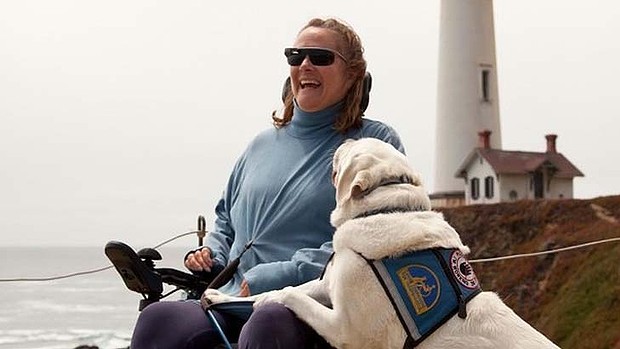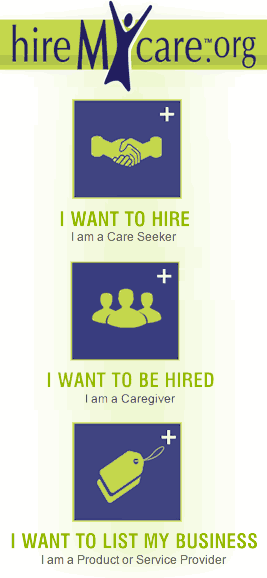Category Archives: Finding Care
Find what you need Faster!
Care Seekers: With our new E-mail Alerts feature, Posting a Job is the fastest way to reach Caregivers in your area. Plus, you’ll be alerted when Caregivers apply or new Caregivers signup in your area.
Caregivers: When you complete your PROFILE, Care Seekers in your area are alerted via E-Mail automatically. Plus, you’ll be alerted when new jobs are posted in your area and Care Seekers will be alerted when you apply to their posted jobs.
Everyone: You get alerts when you have a new Private Message–This could be a job application, an invitation from a Care Seeker or a response to a previous message.
One way to use HireMyCare.org is to run a search to find a caregiver near you, but did you know you can also simply create a job posting and let employees come to you?
It’s that easy. Just log in and click the green “Post a Job” button to get started.
Why Should I create a Job posting to find a caregiver instead of running a caregiver search?
You can do both! But here’s why posting a job is a great way to find caregivers:
- You can create different postings for the different types of care needs you may have. Need transportation to the doctor’s office and also someone to help with your personal care? Create 2 distinct job postings and let employees decide which one best suits their skills and availability.
- A job posting works for you 24/7. HireMyCare.org is still growing, so you may not find what you’re looking for right away when running a search. You may have to return to the site several times as more caregivers in your area sign up. Why not post a job once, and let caregivers search for you? You’ll receive an email alert if someone has responded to your job opening.
- You can close out the posting when you have filled the position, and reopen the same one if you need to fill it again in the future. Sometimes it’s hard to find a caregiver that will stay with you for a long period of time. Many Care Seekers find that they must re-hire for the position several times each year. When you create a job, you can close it out when you have the position filled or re-activate it if you need to replace your caregiver, then modify the posting and re-activate it if your caregiving needs or scheduling needs have changed.
- Like a search, you can tailor your posting and indicate your preferences on 20 different criteria so that caregivers know just what you’re looking for. If you don’t have strong preferences or requirements on some of the criteria, such as caregiver education or experience for example, leave those sections blank so caregivers know you are open and willing to train them to do the job.
If you need help getting started, have a question or suggestions on how we can improve our site, please let us know at [email protected] or give us a call at (855) 285-HIRE (4473).
Looking for someone to help provide in-home care? HireMyCare.org is there 24/7, 365 days a year to help you find qualified caregivers near you. HireMyCare.org isn’t a caregiving agency: We don’t hire caregivers and then loan them out to you: Instead, we put you in charge of recruiting and hiring caregivers in your area that meet your unique scheduling and care needs. We simply provide the online space for your to search!
If you’re a Care Seeker who hires caregivers via HireMyCare.org in your home, you need to be aware that you become the legal Employer of Record. This means that you are required to abide by all local, state and Federal employment regulations, including Equal Opportunity laws.
For example, 10 states and over 50 municipalities have passed the so-called “Ban the Box” laws, which prohibit employers from asking about criminal history on the application form, prior to the first interview, or in some cases at any point before a conditional offer of employment is made. The purpose of such laws is to give job applicants a chance to be evaluated on a case-by-case basis and to explain their criminal history during an interview. Please determine whether you are accountable to this law by searching for your state or locality in this PDF from the National Employment Law Project: http://nelp.3cdn.net/495bf1d813cadb030d_qxm6b9zbt.pdf
 Very important indeed, according to a recent study by the Congressional Budget Office. The study found that the economic value of caregiving for older persons in 2011 to be 234 billion dollars, more than the amount of paid care from all other sources such as Medicare, Medicaid and and community services combined.
Very important indeed, according to a recent study by the Congressional Budget Office. The study found that the economic value of caregiving for older persons in 2011 to be 234 billion dollars, more than the amount of paid care from all other sources such as Medicare, Medicaid and and community services combined.
The magnitude of family caregiving dwarfs other public and private costs associated with providing long-term services and supports to people with disabilities of all ages. Public policies should recognize these contributions and provide greater support for the backbone of our nation’s long-term services and supports system — family caregivers.
Read more about the economic impact of family caregivers on the AARP’s website.

Google Glass is a revolutionary new device that combines a wearable computer with a head-up-display and voice control. Google Glass can be programmed to perform a number of tasks, many of which promise to be very useful for people with disabilities.
For instance, a young programmer/entrepreneur in Stanford has created a facial recognition programmer that helps people with autism recognize and respond to other people’s emotions via Google Glass’s onboard camera and computer.
“As you slip on the Google Glass frames – placing them carefully over your own eyeglasses – you’re told they can read the emotions of the people around you.
These Google Glass frames run an experimental application cooked up by the person you’re looking at – the guy who keeps moving from happiness to surprise and back again. His name is Catalin Voss, and he’s all of 18 years old.
With help from Google Glass, Voss and his co-founder, Jonathan Yan, hope to create a face-tracking engine that can help people to better recognize and understand the expressions and emotions of others. The tool would be a natural for treating autism and related disorders.”
Google Glass is also helping people with severe paralysis return to the hobbies they love.
“It’s been 18 years since Tammie Lou Van Sant held a camera. But nearly two decades after a car accident left her paralyzed from the chest down, Van Sant is shooting again – thanks to a device that could be part of technology’s next big trend.
Google’s Glass headset, which connects to users’ smartphones and displays information on a screen that hovers above one eye, is the first of what analysts say may be a new trend of wearable technology – headsets, watches, fitness trackers and other devices that are worn, rather than slipped into a pocket”
Over the last few decades, devices such as motorized wheelchairs and TDD phones have allowed people to increase their independence and freedom and rely less on those around them for their basic day-to-day needs. Now with Google Glass, the convenience and features of a smartphone are now within the reach of a much wider audience, allowing people with disabilities new ways to share their lives and interact with others.
Kathy from the Salt Lake County Caregiver Support Program tells us of a wonderful moment she witnessed.
“Today I witnessed a heroic caregiver—he simply held his father’s elbow. The man steadied his father’s uneasy movements as he walked into the bank and up to the teller. The father did his own banking, spoke to the teller and quietly put away his paperwork and I.D. The caregiver never said a word, simply kept a light touch on his father’s elbow. The only word I heard the caregiver speak was “Let me get that for you Dad” as he opened the heavy bank door to leave. Sometimes the most important thing we ever say to those we care for is done in body language—no words or instructions required. Thank you caregivers for your kind and supportive actions.”






